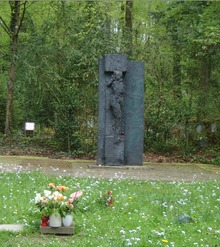Schaffhausen forest cemetery
The Waldfriedhof Schaffhausen is the central cemetery in the city of Schaffhausen in Switzerland .
history
The forest cemetery was designed and built in 1913/14 by the then leading cemetery architect and Munich city planning officer, Professor Hans Grässel, in the Rheinhardwald in the Niklausen district of Schaffhausen. Hans Grässel took the Munich forest cemetery that he had already created as a model. The new forest cemetery, the first of its kind in Switzerland, replaced u. a. the cemetery at what is now the sports facility near Munot . Originally the cemetery covered an area of 4 hectares, but has been expanded several times to its current size of 17 hectares. The grave fields are integrated harmoniously into the forest.
In addition to the central forest cemetery, burials still take place today in the former village cemeteries of the Buchthalen , Herblingen and Hemmental districts that were later incorporated .
From 1911 to 1968 the forest cemetery was connected to the city center by the Schaffhausen tram, and the Schaffhausen trolleybus has taken on this task since 1970 .
Buildings and tombs
The non-denominational abdication hall and other buildings were planned by the well-known Schaffhausen architect Carl Werner. Inside the abdication hall, which was renovated and expanded in 1988/89, there are wall paintings by Carl Roesch . The putti at the entrance and the figures in the two bas-reliefs on the main facade are by Arnold Hünerwadel.
In the forest cemetery there is an interesting collection of gravestones and sculptures from the workshops of Schaffhauser and Swiss artists. Of particular importance are:
- Community grave site for the victims of the mistaken bombing of Schaffhausen on April 1, 1944 by Karl Scherrer / Franz Fischer (1944)
- Honorary grave of the Schaffhausen industrial pioneer Heinrich Moser (1805–1874) and his son Henri Moser (1844–1923)
- Bronze sculpture at the communal grave of Hans Josephsohn (1978)
- Urn grave of Roland Gut / Brigitte Stadler (1987)
Previous cemeteries
Before the forest cemetery was built, there were cemeteries in several places in the city of Schaffhausen:
- Kirchhofplatz: This square in the middle of the old town was used as a cemetery for over 500 years. From 1541, the townspeople turned to the tree garden because of the many victims of the plague.
- Baumgarten (today Mosergarten): The dead were buried here from 1541 to 1864.
- Junkernfriedhof: The meadow in the cloister of the former Allerheiligen monastery was used as a burial place for noble families from 1582 to 1874.
- Rheinhalde (today gasworks area): This cemetery, also known as the military cemetery, was not least the place of rest for the Catholics, it was used from 1628/29 to 1866.
- Emmersberg: The magnificent cemetery, located directly at Munot , was only used between 1864 and 1914. After the rest period had expired, the cemetery was cleared, instead there were plant gardens and later a sports facility.
- Former Steigkirche: It is believed that the cemetery was built in the 13th century. The last occupations took place in the 1930s. Individual graves are still visible today.
Firefly population
The largest population of the little firefly ( Lamprohiza splendidula ) in Switzerland lives in the forest cemetery . Every year, depending on the weather, between mid-June and mid-July, thousands of the animals can be observed for two weeks at dusk.
Individual evidence
- ↑ Schaffhauser Nachrichten of October 29, 2016
- ↑ Thousands of fireflies offer a natural spectacle In: 20 minutes from July 4, 2016
literature
- Zara Teuert-Reckermann: The forest cemetery Schaffhausen (= Swiss art guide . No. 949, series 95). Society for Swiss Art History, Bern 2014, ISBN 978-3-03797-157-4 .
- Information board in the forest cemetery.
Web links
Coordinates: 47 ° 42 '29.6 " N , 8 ° 39' 4.1" E ; CH1903: 691000 / 284883


